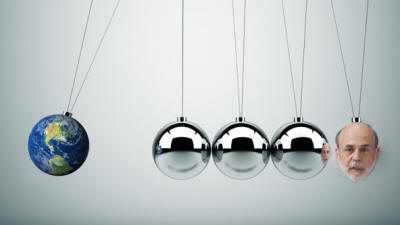|
by David Francis
from
TheFiscalTimes Website
Late last month, leaders from,
...the so-called BRICS, announced they were forming their own development bank to assist other emerging economies.
The yet-to-be-named bank is expected to compete with the World Bank and the International Monetary fund, two institutions with power structures based firmly in the United States and Europe.
The announcement also serves as yet another sign that the world economy is quickly evolving to a place where United States global economic dominance is being challenged by regional interests.
Since the end of World War II, the United States was the driver of global monetary policy. When the Federal Reserve acted, the world listened and reacted.
Now, according to officials from the BRICS nations, emerging countries are trying to insulate themselves from the market shocks caused by the United States and Europe.
They no longer trust the West to do the right thing.
They’re forming their own “union” to create stability that the World Bank, the International Monetary Fund and the Fed have been unable to provide.
The bank, which is planning to raise $50 billion in capital, is expected to open next year, according to Indian finance minister P. Chidambaram.
Other alliances around the world are also forming, portending the end of Western economic dominance.
They don’t share a currency and therefore do not share fiscal policy. Yet they do share the common belief that together, their developing economies can foster and sustain growth.
These alliances do more than simply hedge against Western financial calamities. They encourage investors to keep money in the region instead of sending it to western markets and promote trade between member nations.
Even though many of these alliances lack real teeth, their formation is important symbolically.
They give emerging economies a forum to show their strength, as well as send a clear signal that in the future, the United States is not the only game in town.
Rise of the BRICS
The leaders of these countries first met in 2006, but a formal alliance wasn’t made until 2009. South Africa joined the group in 2010.
These countries now represent more than 3 billion people. They have a combined gross domestic product of $14.8 trillion, and hold $4 billion in foreign reserves. The U.S. economy is still the world’s largest, although experts agree that the Chinese economy will grow larger by 2016.
And while BRICS’ economic growth has slowed in recent years, they weathered the global economic slowdown far better than the United States and Europe.
In fact, the new BRICS bank is likely the direct result of the Western response to the crisis. The Fed, the European Central Bank, the World Bank and the IMF all acted repeatedly to soften the blow of the crisis.
Yet strong growth, both here and in Europe, remains elusive.
According to a paper (The Financial Crisis - Impact on BRIC and Policy Response) by Ritwik Banerjee and Pankaj Vashisht, published at the height of the financial crisis, the ability of the BRICS to sustain growth while Western economies were contracting convinced the emerging nations that a rebalancing of global economic power was necessary.
BRICS Not Alone
During the financial crisis, Japan, China and South Korea created a $120 billion emergency loan fund to shore up Asian nations’ finances. The Association of Southeast Asian Nations, comprised of 10 countries from that part of the world, is also experiencing a period of robust growth.
New partnerships are also emerging closer to home.
Álvaro Uribe, former president of Colombia, recently told The Fiscal Times that his country is considering entering into a formal economic alliance with Mexico, Peru and Chile, creating a bloc with a GDP of $2.2 trillion.
These countries have already agreed to eliminate trade tariffs on 90 percent of the goods exchanged between them.
But the biggest challenge to U.S. dominance remains in Asia.
The Pentagon is shifting its strategy to confront potential rivals in that part of the world. And U.S. companies are gaining ground in huge consumer markets in China, Indonesia and Malaysia.
Even the National Basketball Association recognizes that the key to future success is breaking the Asian market.
It has spent $1.5 billion on a sports and entertainment complex outside of Beijing, and has sent Chinese-American star Jeremy Lin on a tour of the country.
|

